- Home
- Deborah Blum
The Ghost Hunters Page 11
The Ghost Hunters Read online
Page 11
Madame Blavatsky, as she liked to be called, had once lived in Tibet. She claimed to have a mystical connection to the godlike mahatmas of the Himalayas, who had the power of “astral projection”—sending their “astral bodies” to anywhere in the universe while their physical bodies stayed where they were. Her followers said that the mahatmas sometimes rose in a mist from her shoulders—or perhaps that was just the perpetual haze of cigarette smoke. Nevertheless, she could produce the most amazing physical effects. Shattered dishes mended themselves, apports materialized, and sealed letters, bearing personal spirit messages, wafted down from the ceiling of her Manhattan apartment.
Madame Blavatsky promised her followers a world of reincarnation, of balance with universe, and even—with time—of mystic abilities of their own. She had begun her Theosophical Society in New York, publishing a book of her philosophy called Isis Unveiled in 1877, but then moved her headquarters to Madras, India, to be “closer to the source” of her powers. She still spent much of her time in the United States and Europe, spreading her particular gospel. In the summer of 1884, she had attended an SPR dinner in Cambridge, where she charmed the company, despite her “unattractive appearance,” Sidgwick noted. “She is a genuine being, with a vigorous nature both intellectual and emotional, and a real desire for the good of mankind,” he wrote in his diary. He was impressed by her direct way of looking at people, and the down-to-earth cattiness of her conversation: “Thus in the midst of an account of the Mahatmas in Tibet, intended to give us an elevated view of these personages, she blurted out her candid impression that the chief Mahatma of all was the most utter dried up mummy that she ever saw.”
Even Nora liked Blavatsky’s direct manners. Further, the notion of astral projection was a fascinating one, and one that the society was eager to test. But—as happened so often with high-visibility psychics—Madame Blavatsky deftly avoided being tested. She explained that the source of her powers now lay in India. She’d built an elaborately gilded shrine in Madras, glittering with carved vines and blossoms, angels and animals, containing tiny drawers into which spirit letters would suddenly appear. It was unfortunate, she said, that the investigators couldn’t work with her there.
Thus Richard Hodgson found himself in Bombay, admiring the shimmer of the fireflies from a hotel room paid for by Henry and Nora Sidgwick, and organizing a trip to the famous shrine of Madame Blavatsky.
“THE EVIDENCE PUBLISHED by the English society is of a nature not to be ignored by scientific men.” So read the first circular of the American Society for Psychical Research, which was officially founded in early 1885, excited into being by William Barrett, three years after the creation of the British SPR. The American group, however, decided against being led by classical scholars, as the British society was. Its founding members, among them William James, determined to operate on purely scientific methods, to use only trained researchers as investigators. “Not that scientific men are necessarily better judges of all truth than others,” James explained, but even he thought researchers tended to be more believable as experts. Scientists were better trained to gather evidence, “and what we want is not only truth, but evidence.” There was a risk that the researchers’ reputations might be tarnished by association with the occult—one had only to observe the effect on him, or Crookes, or Wallace—but, James noted, “how much easier to discredit literary men or clergymen!”
The ASPR remained open, of course, to members from other disciplines, and they had a respectable few, among them James’s publisher, Henry Holt (still impatiently waiting for the book on psychology); Gardiner Hubbard, who would soon found his own organization, the National Geographic Society; the Asian scholar Crawford Toy, who had been expelled from Southern Baptist Seminary in Louisville for his efforts to reinterpret the Old Testament in the light of Darwinian science; Charles Everett, dean of Harvard’s Divinity School; George Fullerton, a professor of philosophy at the University of Pennsylvania; and Minot Savage, a Boston pastor and author of The Religion of Evolution.
But the founders had chosen an astronomer, Simon Newcomb, who headed the Naval Almanac office, to stand as president, and other scientists, physicists and psychologists, to fill the remaining officer positions. James was especially pleased about Newcomb, whose opinions carried real influence. In addition to his naval appointment, Newcomb was a professor of astronomy at Johns Hopkins, revered for his painstaking mathematical recalculation of planetary orbits. He was the first president of the American Astronomical Society, and a past president of both the American Association for the Advancement of Science and the American Mathematical Society. If Newcomb set the right tone, “he will probably carry the others,” James wrote, hopeful that more mainstream scientists would follow.
NEWCOMB’S TONE, as it turned out, was that of a man who had suddenly realized he had said yes when he meant no.
He began his presidency by writing an article for Science magazine in which he dismissed Barrett’s work on mind reading and all subsequent experiments on the subject by the British society. Real scientists knew, Newcomb wrote, that thought was a mere bodily function, a product of internal chemistry and nervous system impulses, a self-contained product. Newcomb himself had yet to read a single piece of convincing evidence that a thought could be “transferred” from one mind to the other.
Why was it, Newcomb demanded, that if thought reading existed, and presumably had existed for as long as had human thought, “no living person knows any more about the conditions of transference today than men did a thousand years ago?” Why was it that after all his experiments, William Crookes had been forced to go to physicists like Barrett in search of a working theory of action? Why was it that neither chemist nor physicist had been able to provide such a theory?
True, Barrett and his colleagues had produced results suggesting that thought transference did exist, in fact if not in theory. But Newcomb found that easy enough to dismiss. He suspected their findings were simply lucky coincidence, overstated by sloppy research methods. None of the British society’s work impressed Newcomb. He considered Nora Sidgwick’s plan to study reports of haunted houses no more than the process of collecting “very scientific children’s ghost stories.” And he was dismayed that Gurney and Myers had posted ads in the British papers, asking ordinary citizens to write and describe any supernatural experiences. Newcomb didn’t consider that a scientific way to gather information. It made their goal far too public, he scolded. They should have been doing all their data collection by means of private inquiry.
William James had told the new ASPR members that psychical research was “bringing science and the occult together in England and America.” But speaking for science, and speaking as the ASPR’s president, Newcomb hadn’t seen a fact or a study to convince him of that.
Oh, really? replied Edmund Gurney, who was angry enough to fire off a rebuttal letter to Science. Didn’t it make scientific sense to gather a large number of answers and then sift out the silly ones? It was very well to insist only on private inquiry, if one had an unlimited budget and a decade or two to do the work. “It is worrying to think of the stores of authentic evidence which are untapped & which will gradually become unavailable. I believe that the speed with which the subject gets on will depend more than anything else, on the number of cases collected, sifted and classified. It is the unscientific portion of the community that our progress really depends on.”
For all his scientific knowledge, Newcomb seemed unable to understand the research requirements or respect the process of psychical research, Gurney wrote to James, adding that in his opinion the ASPR’s new president had “managed to get considerably off the rails.” Even more, Gurney and his colleagues were dismayed by Newcomb’s frontal attack on thought transference, especially since the British association had made it a goal to see those experiments become accepted science. Myers had even coined a new name for the phenomenon—telepathy, from the Greek tele, “far,” and pathy, “feelings.” The existing term, thou
ght transference, Myers said, was too limited; their experiments tended to show that feelings, sensations, and images also could be conveyed mind-to-mind. He defined telepathy as a transmission, evoking the telegraph and the telephone, summoning the concept of mental messages humming across some as-yet-to-be-discovered strands of energy. Telepathy was fundamental to all supernatural events, Myers said; it could explain premonitions, sympathetic reactions to another’s emotions. Telepathic communication might also prove the best scientific explanation for prayer, at least prayers that seemed to be answered.
Not that the experiments yet came near any such exalted conclusions. But they did consistently suggest that person-to-person communication occurred outside the obvious channels. Myers and Gurney themselves had conducted a neat little series of tests, exploring the ability to transmit a sensation such as taste. The tests were modeled after William Barrett’s suggestion that hypnosis might make a person a better “receiver,” more able to concentrate on reception.
As Gurney described them, some of his more tantalizing results came from studies with two young men, identified only as A, who was put in a hypnotic trance, and B. Both subjects were concealed from each other by a screen. Gurney made no effort to prepare either man for the experiments. He simply brought a package into the test room. The box contained some small vials, each packed with a strong-tasting material. He administered the substances, one at a time, to his two subjects. The result was a sometimes-comical series of exchanges.
“I suddenly and silently gave [B] some salt, motioned to him to put it in his mouth. He did so; and [A] instantly and loudly exclaimed ‘What’s this salt stuff?’ ” Gurney then provided sugar. His hypnotized subject sighed with relief, “Sweeter, not so bad as before.” When Gurney once again gave B a spoonful of salt, A was exasperated: “I told you I liked sweet things, not salt—such a mixture.”
It was the preciseness of these experiments that bothered Newcomb. They seemed to him too good to be true. That went not just for Gurney’s taste tests, but other SPR experiments as well. He especially disliked a series of tests in which one participant was asked to draw a picture and then mentally transmit it. A second participant, sitting blindfolded, was asked to draw the image “received.”
The original drawings were kept simple: the outline of a goblet, the wooden frame of a chair, a fatheaded fish. So were the companion drawings, those sketched out by the receivers. But they were still recognizably fish or furniture, only a little more crooked than the original work. That was what Newcomb found so unlikely, that a person blindfolded could draw so relatively accurately. Therefore he suspected cheating.
By this time, William James had grown as exasperated with Newcomb as Gurney was. James also wrote to Science, attacking Newcomb’s comments on the SPR: “To brand as dupes and enthusiasts a set of gentlemen as careful as these English investigators have proved to be, seems to me singularly unjust.”
And then he dismantled Newcomb’s criticisms, almost point by point. Despite Newcomb’s new ASPR title, James stressed, the gentleman had no experience in these matters. He had not done any observation himself, but merely complained about the work of others. Further, if Newcomb had bothered to test his misgiving about the drawings, he would have seen how feeble it was. James had made a point of checking his own ability to draw blindfolded. With a cloth over his eyes, he found that he could sketch outlines of fish and fruit as well, if not better, than the ones Newcomb criticized. To prove it, James sent some of his drawings to both the journal and Newcomb.
The journal’s editors had printed Newcomb’s text with an admiring editorial note concerning the astronomers “acute observation” of psychical research. James characterized him instead as a “critic without substance.” The one thing everyone could agree on was that this was not a good beginning for the pro-science approach to psychical research.
“THE WHOLE THING is a fraud,” Hodgson wrote to his friend Jimmy Hackett in March 1885, after four months hunting down his quarry, who had now reputedly left India under an assumed name. “I seal and register this letter because part of Madame Blavatsky’s performance consists in getting hold of letters, by bribing or otherwise, steaming them open, getting knowledge of contents and reclosing.” She also amended letters once they’d been opened. Hodgson admitted to a kind of reluctant admiration for her complete nerve: “She is a tolerable imitator of other people’s handwriting, will stick at nothing, and is one of those remarkable clever unprincipled women one reads about but seldom meets.”
His report to the Sidgwicks, also sent sealed and registered, provided the incriminating details at length. Hodgson interviewed witnesses to Blavatsky’s séances. He’d compared letters from the mahatmas with examples of her handwriting. He’d hired handwriting experts to analyze opened letters. He had asked to inspect the shrine and its miraculous cabinet, and when refused the first time, had turned up time and time again, so tirelessly that he’d finally simply worn her guardians out.
Once in, Hodgson had patted and pulled the shrine’s ornate walls until he’d discovered that some of the drawers were double-sided, opening into a chamber behind the gold facade, which turned out to be Madame. Blavatsky’s bedroom. He’d then managed to obtain a confession from her servants that they’d passed letters through the panels into the carved drawers on the other side.
Hodgson had scarcely left the building before it mysteriously burned to the ground, turning its secrets into ashes. He’d no doubt she’d ordered the destruction of evidence. Hodgson sent all the letters he’d collected to Nora Sidgwick, who reanalyzed the writing and was also impressed by the quality of the forgeries, not to mention the quantity.
The SPR’s report on Madame Blavatsky minced no words: “For our own part, we regard her as neither the mouthpiece of hidden seers nor as a mere vulgar adventuress; we think that she has achieved a title to permanent remembrance as one of the most accomplished and interesting imposters in history.”
In its way, Hodgson’s report gave the British SPR a perfect retort to those who characterized them as gullible dupes. It was hard to imagine even the most accredited scientist doing a better job of demolishing a medium’s reputation.
WHAT WAS THE WORST, the most maddening, and the most annoying aspect of being a psychical researcher? It was “this perpetual association in the eyes of the world with ‘intellectual whoredom,”’ Edmund Gurney wrote to William James in the spring of 1885.
Gurney was only repeating a phrase used by the ever-waspish John Tyndall, who was still making it his business to discredit psychical research whenever the opportunity appeared. That attitude, that inflexible hostility, was “the real rub—the thing that occasionally makes the work so trying & galling.” Gurney was tired of Tyndall and his ilk assuming that he and the other SPR members enjoyed listening to stories of Himalayan gods who mailed letters to paying clients, that they thrilled to chasing down “humbug” and con artists, that somehow “this is what one likes.... But I did not mean to give vent to cursing & swearing when I began this letter.”
He did mean to pass along good news. Nora Sidgwick had finished her detailed, coolheaded analysis of ghost stories, almost four hundred in total. And he and Myers had begun sifting through the hundreds of responses they’d gotten through advertising for personal accounts of visions and dreams.
As Gurney told James, “Our plan has been to spread the nets very wide, get a big haul, & then viciously sift. Perhaps 5 per cent of the cases sent or heard of bona fide prove worth something. But we should never have got the 5 if we had not laid ourselves open to the 95.” What kind of story fell into that golden 5 percent? One of Gurney’s favorites came from a country squire in eastern England.
In the mid-1870s, the squire had for a neighbor a young man who owned a farm that ran adjacent to his lands. They occasionally hunted together, occasionally had a drink, but the older and younger man did not build what one would call a strong friendship.
On a chilly March evening in 1876 the squire met his ne
ighbor walking across the corner of his estate, and they fell into conversation, mostly somber, about the low prices of farm produce. As they walked back toward home, the young man invited the squire to “come and smoke a cigar.”
This neighbor had rarely been so hospitable, and the older man was a little surprised. He had to refuse, though, explaining that he had a dinner engagement. Yet the other man seemed unusually anxious about the rejection, repeating the invitation several times, before saying good-bye.
About ten that night, after he’d returned home again, the squire went into his library to retrieve a book he was reading on the natural history of birds. He had barely settled into an armchair, near the window, when he heard the front gate open and shut, and a hurry of footsteps approaching the house. The stone walls of his house suddenly seemed transparently thin; he could hear the visitor’s labored breathing. And then a scream, a wail of horror, fading into sobs of agony.
“Of my fright and horror I can say nothing—increased tenfold when I walked into the dining room and found my wife sitting quietly at her work close to the window.” The squire’s wife had heard nothing, but looking up, catching a glimpse of her husband’s pale face, she said, immediately, “What’s the matter?”
“Only someone outside,” he replied.
“Why not go out and look, as you always do when there’s a strange noise?” she inquired.
“There is something so queer and dreadful about the noise,” he answered, and he remained with her, in that comforting circle of domesticity.
He hadn’t been willing to step into the dark just then.
In the morning, though, the squire went out to look for footprints. The ground and paths were frosted with cold. They sparkled in the sun. The glittering surfaces were unmarked, except by the light tracks of a passing hare. There were no marks where he had heard the visitor approach. He couldn’t understand it.

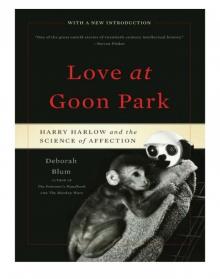 Love at Goon Park: Harry Harlow and the Science of Affection
Love at Goon Park: Harry Harlow and the Science of Affection The Poison Squad
The Poison Squad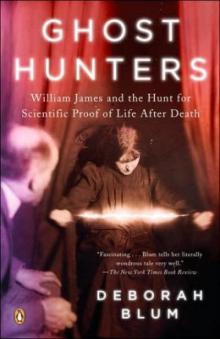 Ghost Hunters: The Victorians and the Hunt for Proof of Life After Death
Ghost Hunters: The Victorians and the Hunt for Proof of Life After Death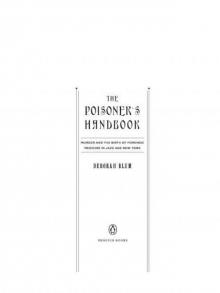 The Poisoner's Handbook
The Poisoner's Handbook Angel Killer
Angel Killer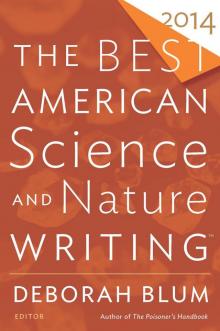 The Best American Science and Nature Writing 2014
The Best American Science and Nature Writing 2014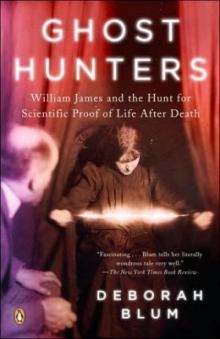 The Ghost Hunters
The Ghost Hunters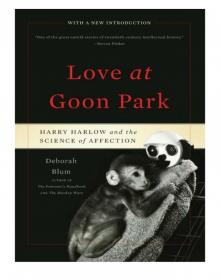 Love at Goon Park
Love at Goon Park